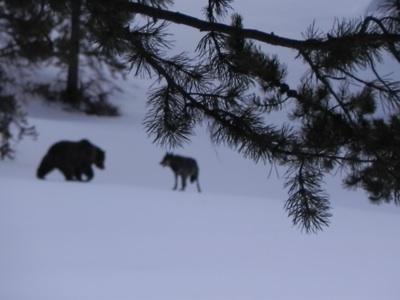How do grizzly bears and wolves in Yellowstone National Park carry on when they don't think anyone is watching? Well, as these pictures show, they're not going after each other tooth and claw.
Nancy Ward, the park's acting chief of maintenance, was heading to Lake for a meeting back on May 4, before the park's interior roads were open for the public, when she spied a wolf and another animal in a snow-covered drainage.
As she continued on, she thought the other animal might be a bison struggling in the snow. With some time to spare, she turned around and headed back to where she had seen the animals. This is what she discovered:
There was a spot cleared right across the river from these two. Once I stopped I was able to look closely and saw the wolf was "playing" with a grizzly bear. I thought they might be attracted to a carcass, but there was no food around. The bear rolled on its back with its feet in the air. It also slid around the snow. The wolf stayed close, checking things out. The bear approached the wolf and they appeared to sniff around each other and on the ground. I had my camera so I took several pictures. They interacted for more than five minutes and then they both walked up the small drainage and out of sight. I don't know if that's a common type of encounter, but I doubt I will ever see it again!




Comments
Amazing catch, Nancy! Thanks for sharing. Congrats on the acting position as well.
The wolf is following the bear because the bear digs up things (old dead animals). The wolf lets the bear do the hard work then comes in for the little pieces. It appears in the picture they are close but in reality the wolf is probably 10 feet in front or behind the bear. It's just the angle of the picture that throws things off.
Man: The only animal that doesn't communicate.
Bears are bigger than wolves. If you see a photo where they look similar in size -- like these -- it means that the wolf is a lot closer to the camera than the bear. He is keeping a healthy distance.
Just curious, but did you actually read the story?
They are both on their way to punch their timecards for the day. Everything I needed to know I learned from Looney Tunes.
You remember that cartoon:
It looks to be a juvinile bear. As such it's not a lot bigger than a full grown adult wolf. I love the speculative explanations about perspective though...except they seem to fly in the face of logic considering the 2nd picture has the wolf behind the bear, sniffing at its legs.
As I understand it, young bears can be quite playful, are highly curious and can be social with other animals. Wolves have many of the traits of dogs as social animals. It is not a complete shock to see to two social animals who aren't competing for food or territory interact like this.
It's an amazing photo set, but only for the rarity of being able to capture such an event as I'm sure it usually happens away from the eyes of man - it's fortunate that neither subject noticed the human taking photos in that regard.
Probably looking for Bagheera and Mowgli.